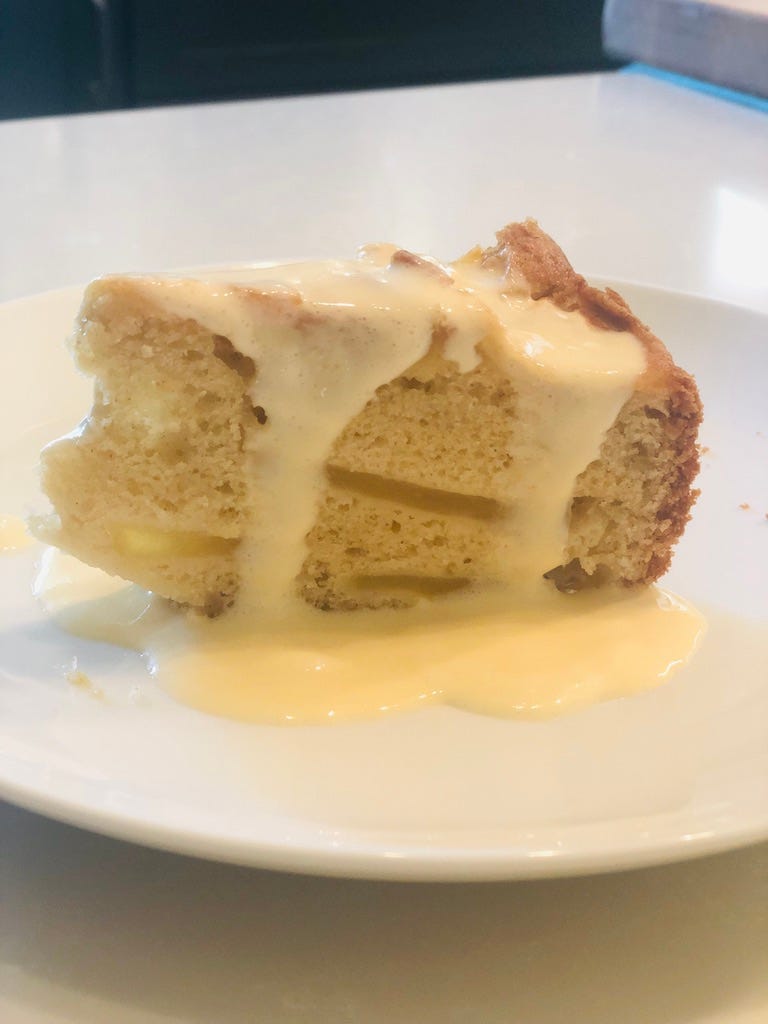Anglaise
The “mother sauce” of desserts is stupid easy, highly versatile, and freaking delicious.
We’ve been on a streak of dessert preparations lately, including cakes, cream puffs, ice cream, sorbet, frostings, and so on. On an unrelated note, I’ve mysteriously gained 5 pounds.
But seriously, building off the ideas I raised in Pastry, it’s amazing how connected cooking is once you’re taught the underlying fundamentals of how things are made. This is particularly true with desserts, and demonstrably true in the case of creme anglaise.
Fancy word, sure. After all, it’s French. But it’s deceptively simple to make. And once learned, it has many applications that suddenly turn one technique into multiple dessert options. Which is why it’s called the “mother sauce” of desserts by some.
You may not realize it, but you’ve almost certainly had creme anglaise many times. In its purest form, creme anglaise is often drizzled over baked desserts like bread pudding. But most of us are familiar with its chilled and stirred form — ice cream. Or it’s baked form — creme brulee.
Add corn starch during the mixing process and you have pastry cream (the custard filling in pastries). Add butter and you have cake frosting (buttercream). Add gelatin and you have panna cotta.
While creme anglaise is technically “vanilla sauce” it’s not only for vanilla flavors. It’s the base for any other dessert cream… chocolate, fruit, caramel, etc. You can infuse it with booze (bourbon sauce) if you want.
But sticking to the basic recipe, creme anglaise is an eyerollingly simply thing to make that can instantly sex up nearly any dessert and make you look like a rock star. Just don’t look for a healthy version.
Note: you may read recipes calling for half and half. That’s half milk, half cream. You probably already have both milk and cream in your fridge. You don’t need another container of half and half… just mix the two in equal parts.
Creme Anglaise
(makes ~2 cups)
8 oz whole milk
8 oz heavy cream
4 oz sugar
7 egg yolks, whisked
1 t vanilla extract
Mix milk, cream, vanilla, and sugar in a pot and slowly bring to a scald (where the edges start to bubble just before it breaks into a boil. Don’t let it boil). Stir to incorporate the sugar until it dissolves.
Once at a scald, slowly pour about a third of the hot dairy mixture into the eggs, whisking quickly. (This is called tempering. The idea is to get the temperature of the eggs close to that of the dairy so it’s easier to combine the two without curdling the eggs).
Pour the tempered eggs into the pot w/ the dairy, whisking while doing so.
Continue cooking and stirring (and not letting it boil) until the sauce is thick. (Test by coating the back of a spoon w/ the sauce and drawing your finger across it. If the streak you made with your finger holds, it’s thick enough. This is called “nappe”).
Pour through a fine mesh strainer into a metal bowl sitting in an ice bath (which is another bowl filled with water and ice). Stir strained sauce until cool.
Cover and refrigerate until ready to use.
Of all the steps here, the most important is the tempering. Adding cold egg yolks to hot anything will create scrambled eggs. The key is to slowly bring the egg yolks to the heat of the liquid before fully combining them.
Uses:
Drizzle it over brownies, coffee cakes, pies, or other store-bought baked goods
Pour over caramelized bananas, fruit compote, or just plain strawberries
Add it to oatmeal if you want to a sweet breakfast, or even better… French toast.
Spoon it over bread pudding with some berries
It’s useful to know what each ingredient is doing while cooking. The half/half provides the creaminess. The yolks, when heated, cause it to thicken and provide more fat. The sugar sweetens it. The vanilla flavors it. So if you want to make variations, these are the levers to pull. Want a looser sauce, use less yolks. Thickener sauce = more yolks. Less sweet = less sugar.
Once you get going with it you can replace the vanilla with other flavors by simply infusing the half and half (mint, cinnamon sticks, whatever), or start playing with the other variations mentioned above, like creme brulee or ice cream.
(Note: you need an ice cream maker to make ice cream. No workaround on that. I asked my instructor what do do if you didn’t have an ice cream maker and her response was “Don’t make ice cream.”)
So if you’re ever following a recipe for a dessert that requires cooking dairy, egg yolks and sugar on a stovetop, that step of the recipe is making creme anglaise. Breaking recipes down by component like this makes them not only easier to follow, but also easier to successfully pull off.


